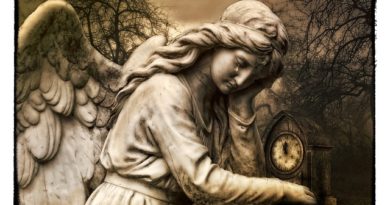Lord of the Gates of Hell
By Derek Gilbert
Over the centuries, tomb robbers have removed most of the useful evidence from the dolmens of the Jordan River valley. The few bones left behind in burial chambers don’t show any evidence of giantism, or at least I haven’t found any papers reporting it. Most of the dolmens are oriented north-south, although about 10 percent appear to be oriented east-west, perhaps to face the rising sun.
Is this significant? While it’s interesting to note that the Pole Star was Thuban (Alpha Draconis) in the constellation Draco, the Dragon, when the dolmens were built, we don’t know if that was relevant. Despite their ability to lift stupendously heavy blocks of stone, the dolmen-builders weren’t considerate enough to leave behind any written evidence.
That makes a recent discovery in the Golan all the more intriguing and frustrating at the same time. In 2012, archaeologists examined a massive, multichambered dolmen in the Shamir Dolmen Field on the western foothills of the Golan Heights, a site with over four hundred dolmens. What was truly remarkable about this particular dolmen was the discovery of rock art on the underside of the capstone, a basalt monster weighing about fifty tons. (For comparison, that’s about twice as heavy as a fully-loaded, eighteen-wheel, tractor-trailer in the United States.)
That’s the first time art has been found inside any of the thousands of dolmens in the region, possibly the first written or artistic record that might be connected directly to the biblical Rephaim.
The dolmen itself is surrounded by a tumulus, a burial mound of about four hundred tons of stone. Think about that! Four thousand years ago, maybe a century or so before Abraham arrived in Canaan, a government on the Golan Heights was powerful enough to organize the manpower and logistics (food, water, etc.) to move and assemble some eight hundred thousand pounds of stone into a multichambered tomb for—who? The king and his family? Archaeologists recovered enough bones and teeth to identify “an 8–10 year-old child, a young adult and a 35–45 year-old adult.”

Were they—dare we speculate—of the dynasty that produced Og, the enemy of Israel, about six hundred years later? Well, probably not. Most dynasties don’t last that long. But it’s interesting to wonder.
The engravings were fourteen figures comprised of a vertical line and a downturned arc. What did the symbol mean? No idea. Nothing like it has been found anywhere in the Levant or anywhere else.
It might be a representation of the human soul taking flight, but because the artist didn’t leave a note, we’re guessing. Or—and again, we’re speculating—this could be an ancient symbol with occult meaning even today. Three-dimensional scanning of the images show that at least some of them look very much like the Greek character psi, which is a trident (and the logo for Indiana University), the three-pronged spear traditionally carried by the Greco-Roman god of the sea, Poseidon/Neptune.
Today it’s used, among other things, as a symbol for parapsychology, especially research into extrasensory perception, and in a mathematical formula that claims to guide occultists in how to perform rituals in chaos magick.
What did that symbol mean in the twentieth century BC? We have no way to know. It might have been doodling by a bored Bronze Age stonemason.
The takeaway is this: For at least a thousand years, people living in lands the Bible identifies as the home of Rephaim tribes built burial tombs with massive slabs of limestone and basalt. And those huge burial tombs inspired place names linked to the dolmen-builders (Iye-Abarim, “ruins of the Travelers”) and to the restless dead (Oboth, “Spirits of the Dead”).

Get this: Even the place where Moses died was called the Mountain of the Travelers.
Go up this mountain of the Abarim, Mount Nebo, which is in the land of Moab, opposite Jericho, and view the land of Canaan, which I am giving to the people of Israel for a possession. And die on the mountain which you go up, and be gathered to your people, as Aaron your brother died in Mount Hor and was gathered to his people.…
So Moses the servant of the Lord died there in the land of Moab, according to the word of the Lord, and he buried him in the valley in the land of Moab opposite Beth-peor; but no one knows the place of his burial to this day. (Deuteronomy 32:49–50, 34:5–6, emphasis added)
Here’s a thought: Moses was buried in the valley of the Travelers, a place where the Rephaim spirits were believed to cross over to the land of the living. Is that why Satan, lord of the dead, thought he had a claim to Moses’ body after his death? See Jude 1:9.
Another question comes to mind: Were all those dolmens up and down the Jordan Valley thought to be portals to the underworld?
Here’s another connection between this valley and the realm of the dead: Remember the prophecy of Balaam? After the king of Moab tried to buy a curse from the pagan prophet, Israel began drifting away from Yahweh again.

While Israel lived in Shittim, the people began to whore with the daughters of Moab. These invited the people to the sacrifices of their gods, and the people ate and bowed down to their gods. So Israel yoked himself to Baal of Peor. And the anger of the Lord was kindled against Israel. (Numbers 25:1–3)
Who was Baal of Peor? Remember, baal in Hebrew simply means “lord.” So, the Lord of Peor was a local deity linked to a mountain near Shittim in Moab, northeast of the Dead Sea. The clue to the character of Baal-Peor is in the name.
Peor is related to the Hebrew root p’r, which means “cleft” or “gap,” or “open wide.” In this context, that definition is consistent with Isaiah’s description of the entrance to the netherworld:
Therefore Sheol has enlarged its appetite and opened [pa’ar] its mouth beyond measure. (Isaiah 5:14)
Since we’re looking at a place associated with the dead, it’s worth noting that the Canaanite god of death, Mot, was described in the Ugaritic texts as a ravenous entity with a truly monstrous mouth. N. Wyatt’s Religious Texts from Ugarit notes:
He extends a lip to the earth,
a lip to the heavens,
he extends a tongue to the stars.
That’s what’s in view here: Baal-Peor was apparently the lord of the entrance to the underworld—or, at the risk of being sensationalistic, “Lord of the Gates of Hell.”
Yes, the Canaanites believed the entrance to the underworld was at Bashan. But both Milcom (whom the Hebrews called Molech) and Chemosh, the national gods of Ammon and Moab, the nations that controlled most of the land east of the Jordan from the Dead Sea to Mount Hermon, demanded child sacrifice. Veneration of the dead and appeasing the gods of the dead through human sacrifice appear to have been the norm in this region east of the Dead Sea.
This was also the location of Sodom and Gomorrah. This is an awful lot of evil concentrated in a small area.
Anyway, perhaps because of the association with death and the dead, there was, shall we say, a fertility aspect to the cult of Baal-Peor.

And behold, one of the people of Israel came and brought a Midianite woman to his family, in the sight of Moses and in the sight of the whole congregation of the people of Israel, while they were weeping in the entrance of the tent of meeting. When Phinehas the son of Eleazar, son of Aaron the priest, saw it, he rose and left the congregation and took a spear in his hand and went after the man of Israel into the chamber and pierced both of them, the man of Israel and the woman through her belly. (Numbers 25:6–8)
How to put this delicately? There are only a couple of physical positions in which Phinehas could have speared both the Israelite man and Midianite woman with one thrust. If you’re an adult, I don’t need to draw you a picture. Emphasizing the point, the Hebrew word translated “belly,” qevah, can refer to a woman’s womb. In other words, the sin here wasn’t that an Israelite man brought a foreign woman home for dinner, it’s that the couple performed a lewd ritual act in full view of Moses and the assembly of Israel!
Well, it’s no wonder the men of Israel were tempted to follow Baal-Peor. Roughly 60 percent of the Christian pastors in America today struggle with addiction to pornography. Just imagine the temptation of being surrounded by people whose god decreed that extramarital sex was a form of worship. We don’t mean to be flippant, but it might take the real threat of death to keep men away from the temples! Indeed, twenty-four thousand people died in the plague that God sent as punishment for that apostasy because it wasn’t just the one couple involved.
And there was even more to it than that. Not surprisingly, given the Amorite/Rephaim culture in that time and place, one of the pagan rites the Israelites adopted during their time in Moab was veneration of the dead:
Then they yoked themselves to the Baal of Peor,
and ate sacrifices offered to the dead;
they provoked the Lord to anger with their deeds,
and a plague broke out among them. (Psalm 106:28–29)
The psalmist remembered the sacrifices to the dead, which is a basic description of the Amorite kispum ritual. The sexual sin of the young couple (and Phinehas’ violent reaction) is shocking to us today, but apparently the psalmist didn’t find it worth mentioning. The real sin that provoked God’s anger was venerating the dead, one of the “abominable practices” of the pagan nations He’d promised to drive out of the land before them.
That brings us back to the point: We’ve identified the area that Ezekiel called the Valley of the Travelers as the east side of the Jordan Rift Valley, specifically ancient Moab east and just northeast of the Dead Sea. And by now you’re asking, “Why are we spending all of this time identifying the area and unraveling the meaning behind the word Travelers?”
Here’s why: It connects the Rephaim to Ezekiel’s prophecy of Gog and Magog.
How? Stay tuned.

Derek Gilbert hosts SkyWatchTV, a weekly Christian television program, and co-hosts SciFriday, a weekly television program that looks at science news with his wife, author, and analyst Sharon K. Gilbert. His broadcast career spans nearly four decades, with stops in Little Rock, Saint Louis, and Philadelphia, and he’s been interviewing guests for his podcast, A View from the Bunker, since 2009. Derek is author of the groundbreaking books The Great Inception and Last Clash of the Titans. He’s also the co-author with Josh Peck of The Day the Earth Stands Still, which exposes the occult origins of the modern UFO phenomenon. Bad Moon Rising: Islam, Armageddon, and the Most Diabolical Double-Cross in History was released in the summer of 2019. Derek and Sharon recently released Veneration: Unveiling the Ancient Realms of Demonic Kings and Satan’s Battle Plan for Armageddon, about ancient death cults and the Bible. Their newest book, Giants, Gods, and Dragons: Exposing the Fallen Realm and the Plot to Ignite the Final War of the Ages, was released November 30, 2020 and became a #1 “Hot New Release.” His newest book, The Second Coming of Saturn: The Great Conjunction, America’s Temple, and the Return of the Watchers, was just released on November 15. Derek is a popular conference speaker, a lifelong fan of the Chicago Cubs, prefers glasses to contacts, and has been known to sing the high part in barbershop and gospel quartets. Find out more: www.derekpgilbert.com, www.gilberthouse.org, www.vftb.net, and www.SkyWatchTV.com.



